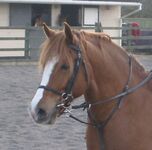
16 years ago a bright orange Welsh Cob with an utterly endearing face travelled here from Yorkshire. Last week, at the age of 23, she left, peacefully and with a minimum of drama, and I lost a very special friend.
Boots arrived, as you can see, complete with tack which suggested that, to control her, her head had to be kept from getting too high. Nothing could be further from the truth, Boots was very much on the forehand very much of the time - unless confronted with something she wasn't sure of (memorably, mating alpacas, or a fuel bowser parked at the side of a remote forestry track), at which point her head would become very high indeed and her whole body would become as if turned to stone. At these times, any attempt to encourage her to move forward before she was ready would be either completely ignored (alpacas) or, if the path had deep bramble filled ditches on either side, met with rapid and reckless reversing (bowser) accompanied by threats to turn round and run very fast back the way we had come. So she taught me one of countless lessons - that force would not work, I must sit still, stay calm and wait for her to think it through. Eventually (alpacas) she would breathe out, relax and walk on as if nothing had happened, or (bowser) she would gather up her courage, close her eyes, and gallop past the scary object until a safe distance was achieved, then walk on as if nothing had happened.
There is a famous saying attributed to Lao Tzu in the Tao Te Ching: 'When the student is ready, the teacher will appear.'
There have been horses in my life since I was very small - imaginary or fictitious at first but real since the age of 8 when I received riding lessons for my birthday. My mother had ridden as a teenager, and thinking back I now realise the subsequent years of yearning and dreaming which led her to buy a yearling Welsh Mountain pony when I was 16. We basically knew nothing - although I had read a LOT of books and knew by heart the Pony Club Manual of Horsemanship - but we had a real pony of our own and the adventure began.
Fast forward over 30 years of riding, owning, learning about and working with horses, all based on the well embedded, tried and tested adversarial British methods I grew up with ('Show him who's boss', 'Don't let him away with it', 'He's testing you', 'He's just lazy'), and informed by a series of mentors who had grown up in the same if-it-doesn't-behave-hit-it-with-a-stick tradition.
During those years a few other things happened which are pertinent to my tale: a B.Sc(Hons) in Zoology; I developed an interest in posture, use and movement through study of the Alexander Technique; I began to discover the world of energy balance and the body-mind-spirit connection through study of equine and human Shiatsu; and I found in our local library a small unassuming paperback book called 'Centered Riding', which described an approach to riding based on the Alexander Technique and martial arts. How I longed to find someone who could teach me this way.
Then the teacher appeared.
Boots arrived, as you can see, complete with tack which suggested that, to control her, her head had to be kept from getting too high. Nothing could be further from the truth, Boots was very much on the forehand very much of the time - unless confronted with something she wasn't sure of (memorably, mating alpacas, or a fuel bowser parked at the side of a remote forestry track), at which point her head would become very high indeed and her whole body would become as if turned to stone. At these times, any attempt to encourage her to move forward before she was ready would be either completely ignored (alpacas) or, if the path had deep bramble filled ditches on either side, met with rapid and reckless reversing (bowser) accompanied by threats to turn round and run very fast back the way we had come. So she taught me one of countless lessons - that force would not work, I must sit still, stay calm and wait for her to think it through. Eventually (alpacas) she would breathe out, relax and walk on as if nothing had happened, or (bowser) she would gather up her courage, close her eyes, and gallop past the scary object until a safe distance was achieved, then walk on as if nothing had happened.
There is a famous saying attributed to Lao Tzu in the Tao Te Ching: 'When the student is ready, the teacher will appear.'
There have been horses in my life since I was very small - imaginary or fictitious at first but real since the age of 8 when I received riding lessons for my birthday. My mother had ridden as a teenager, and thinking back I now realise the subsequent years of yearning and dreaming which led her to buy a yearling Welsh Mountain pony when I was 16. We basically knew nothing - although I had read a LOT of books and knew by heart the Pony Club Manual of Horsemanship - but we had a real pony of our own and the adventure began.
Fast forward over 30 years of riding, owning, learning about and working with horses, all based on the well embedded, tried and tested adversarial British methods I grew up with ('Show him who's boss', 'Don't let him away with it', 'He's testing you', 'He's just lazy'), and informed by a series of mentors who had grown up in the same if-it-doesn't-behave-hit-it-with-a-stick tradition.
During those years a few other things happened which are pertinent to my tale: a B.Sc(Hons) in Zoology; I developed an interest in posture, use and movement through study of the Alexander Technique; I began to discover the world of energy balance and the body-mind-spirit connection through study of equine and human Shiatsu; and I found in our local library a small unassuming paperback book called 'Centered Riding', which described an approach to riding based on the Alexander Technique and martial arts. How I longed to find someone who could teach me this way.
Then the teacher appeared.
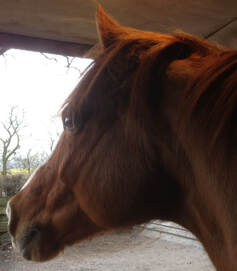
She was accompanied by a few accessories: three months after Boots arrived I began a Master's degree in Equine Science at Edinburgh University's 'Dick Vet' Veterinary School - a dream year of full time study which altered completely the way I related to horses - during which I became good friends with a fellow student who introduced me to a parallel horsey world populated by horsemen whose names were Dorrance, Nye, Parelli, Rashid, Halfpenny, Brannaman, Hunt and Desmond and underpinned by the principles of scientific learning theory. I began to shed everything I had brought with me to that point, and prepared to begin again at the beginning. And just as I was wondering who on earth I could turn to who would understand and help me learn in this new direction, something magical happened: a tiny little advert in the back pages of Horse & Hound magazine advertising a Centered Riding Clinic in the UK. I called the number, expecting to hear that the clinic was a) full and b) hundreds of miles away, to discover that there was space and that the clinic was here, in Scotland.
I'll never forget the atmosphere of calm around that clinic, of an entire ride changing direction on a thought, and of the glimpses of awareness beginning to come through as we were given space and time to think, experiment, discover and interpret. Of beginning to feel the living body underneath me respond to my breath, of beginning to realise just how quiet it was possible to be, that there was no need to kick, pull, hit or otherwise metaphorically yell at this gentle creature who would do her very best if only I could provide her with clear information. For the first time in my whole riding life I was being encouraged to discover and work things out for myself, instead of just being told what to do.
I'll never forget the atmosphere of calm around that clinic, of an entire ride changing direction on a thought, and of the glimpses of awareness beginning to come through as we were given space and time to think, experiment, discover and interpret. Of beginning to feel the living body underneath me respond to my breath, of beginning to realise just how quiet it was possible to be, that there was no need to kick, pull, hit or otherwise metaphorically yell at this gentle creature who would do her very best if only I could provide her with clear information. For the first time in my whole riding life I was being encouraged to discover and work things out for myself, instead of just being told what to do.
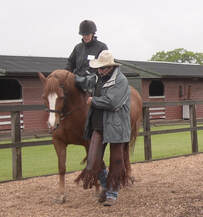
So the journey began. There is something wonderful about spending days at a time, just you and your horse, learning. For others, it's about competing and working towards specific goals, but for me, the learning is enough. Boots and I rode for miles in the forest and worked in the school, always learning. We learned about softness and feel from master horsemen like Steve Halfpenny and Mark Rashid, and we learned the foundations of Centered Riding from clinicians who had been apprentices of its founder Sally Swift.
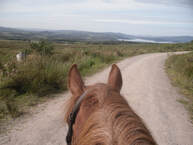
I traveled twice to Vienna, to seminars at the Spanish Riding School, and brought back the learning of precision and attention to detail offered by a different community of masters such as Arthur Kottas and Andreas Hausberger. To stand in the hallway of that ancient institution, read the names of the riders going back 500 years in an unbroken line, and know that in a very small way one is a part of it all is a very special experience indeed.
And all the time, Boots was there, patiently letting me experiment, answering my questions, teaching me to observe, to read the horse, to notice the small tries and changes, to feel and to soften.
In this past year I have begun to come across a branch in the road which is suggesting the possibility of achieving an even greater depth of understanding and communication, using a branch of neuroscience known as polyvagal theory. At its heart is the requirement to recognise the emotional state of the horse during his interactions with us, and to respond appropriately in a way which communicates that recognition. It's very exciting and very effective, but demands a high degree of emotional maturity on the part of the horseman. More to learn - bring it on!
There's a less well known part to Lao Tzu's quote: 'When the student is truly ready, the teacher will disappear.'
I'm ready for the next part of my journey. Farewell, my beloved teacher. And thank you.
And all the time, Boots was there, patiently letting me experiment, answering my questions, teaching me to observe, to read the horse, to notice the small tries and changes, to feel and to soften.
In this past year I have begun to come across a branch in the road which is suggesting the possibility of achieving an even greater depth of understanding and communication, using a branch of neuroscience known as polyvagal theory. At its heart is the requirement to recognise the emotional state of the horse during his interactions with us, and to respond appropriately in a way which communicates that recognition. It's very exciting and very effective, but demands a high degree of emotional maturity on the part of the horseman. More to learn - bring it on!
There's a less well known part to Lao Tzu's quote: 'When the student is truly ready, the teacher will disappear.'
I'm ready for the next part of my journey. Farewell, my beloved teacher. And thank you.
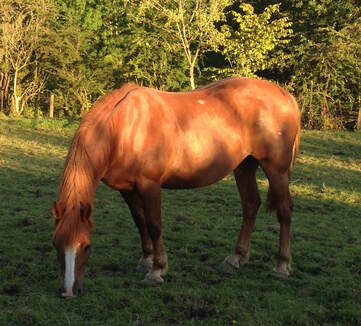
 RSS Feed
RSS Feed